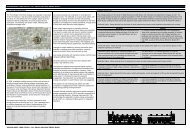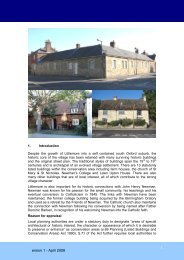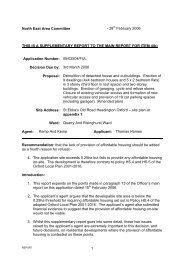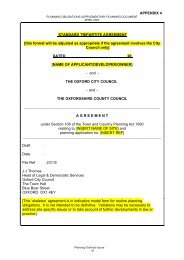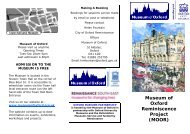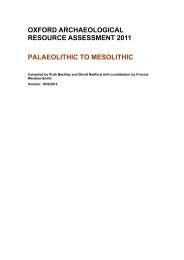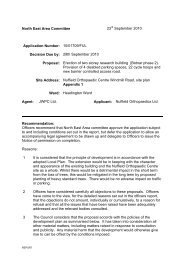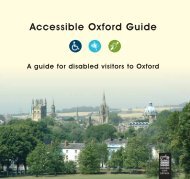Post-medieval Oxford - Oxford City Council
Post-medieval Oxford - Oxford City Council
Post-medieval Oxford - Oxford City Council
You also want an ePaper? Increase the reach of your titles
YUMPU automatically turns print PDFs into web optimized ePapers that Google loves.
A number of plant remains assemblages excavated in <strong>Oxford</strong> have demonstrated the<br />
rich variety of fruit consumed in the post-<strong>medieval</strong> period. At the Ashmolean Museum<br />
Extension,16th-17th century samples contained fig and blackberry (Smith 2009).<br />
Plant remains recovered from the site of Black Hall Farm at the north end of St Giles<br />
also suggested that the occupants enjoyed a varied fruit diet, including raspberry,<br />
grape, plum and fig during the post-<strong>medieval</strong> period (Robinson 2010). The 16 th<br />
century kitchen waste from Lincoln College contained traces of figs and grapes<br />
(Pelling 2002). At Corpus Christi College, plant remains from the 16th–18th century<br />
cessy fill of a cellar and an 18th century stone-lined cesspit produced rich<br />
assemblages, including large quantities of grape and other fruit pips, notable for<br />
demonstrating fruit consumption in the Georgian period. Samples were recovered<br />
from a stone-lined cess pit within the Bastion 21, and it is likely that they originate<br />
from the President’s Lodging, which may go some way to explaining the apparently<br />
rich diet (Nicholson 2009).<br />
Leisure pursuits<br />
Bowling greens<br />
The Bowling Green in Magdalen College Grove shown on post-<strong>medieval</strong> maps was<br />
one of several in existence in this period. Fairfax and Cromwell are reputed to have<br />
used it (VCH iv). Another green was located at Gloucester Green before the city gaol<br />
was constructed. A green was also located at New College and at Holywell, which<br />
was converted into a garden in the 19th century.<br />
Real tennis<br />
Real tennis was introduced in England in the 15 th century, although no <strong>medieval</strong><br />
examples remain. The earliest recorded tennis courts in <strong>Oxford</strong> lie on the east and<br />
west sides of Smithgate in 1530 (Potter 1994). The eastern one, shown on Loggan’s<br />
map, became a book store in 1695 (VCH iv). A tennis court is recorded at Cardinal<br />
College in 1546 (VCH iv); the surviving 17th century building was recorded before it<br />
was demolished in 1966 for Blue Boar Quadrangle (Wilson and Hurst 1966). A tennis<br />
court in Merton Street, behind <strong>Post</strong>master's Hall, was in use by 1595 (VCH iv). It is<br />
still in existence and has been subject to a watching brief and photographic survey<br />
(UAD 608; RCHME 1992). To the rear of Nos 3-8 Oriel Street, there is the shell of a<br />
covered tennis court probably of the 16th century. The tennis court was investigated<br />
in 1989-90 (<strong>Oxford</strong> Archaeological Unit 1989; Durham 1991; Durham and Tyler 1993;<br />
Munby 1995). The tennis courts were initially laid out as an open court in 1572 before<br />
a roof was added in around 1600 (ibid.: 94). A series of mortar floors were recorded<br />
dating to the 16 th and 17 th centuries. Several real tennis balls have been recovered<br />
from the town as stray finds (UAD 931). The roof has been dendro-dated, showing<br />
that the wall plate was of timber felled in 1637, implying that the court was newly built<br />
when Charles I and Prince Rupert played there in 1642 during the siege of <strong>Oxford</strong>.<br />
Race track<br />
A horse racing track is recorded on Port Meadow from the late 17 th century at least;<br />
the earliest reference is dated 1695 (Cordeaux and Merry 1948: 56). By 1720, the<br />
race track had been established as a pear-shaped circuit in the northern part of the<br />
meadow, illustrated on the 1720 Port Meadow map by Benjamin Cole (VCH iv). The<br />
event continued on a regular basis until the start of the 20 th century (ibid.: 65). Traces<br />
of an 18th century race track can be seen as grass marks on Port Meadow.<br />
Cockfighting<br />
The cockpit north-east of Holywell Manor was in existence by the later 17th century.<br />
By 1750, it had become the Cockpit Inn and it was demolished in 1845 (VCH iv).<br />
OXFORD ARCHAEOLOGICAL RESOURCE ASSESSMENT- POST MEDIEVAL<br />
36



